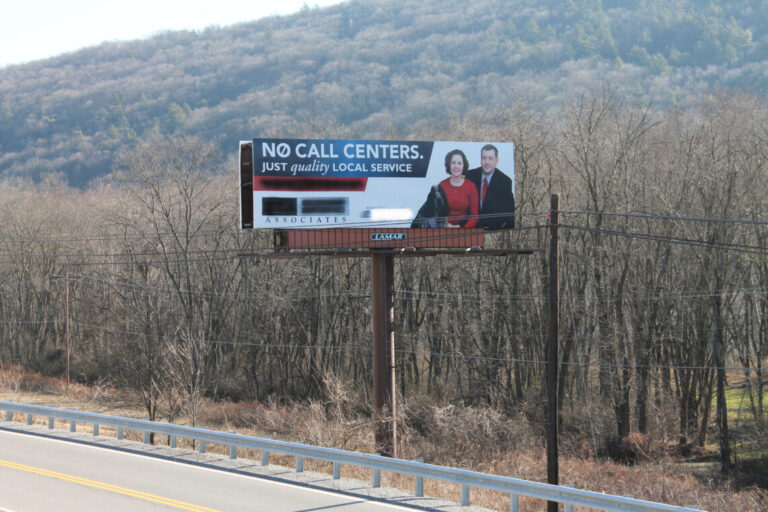
No Call Centers. Just Quality Local Service.
The billboard seemed to mock me and my very existence. I felt angry, frustrated, and defeated. How dare they boldly attack my profession?
Abolish call centers! What gave them the right?
But of more concern, was this really how most people felt about their experience with the frontline teams that were intended to serve and support customers?
Would we all just be better off if we rid ourselves of call centers?
I refused to believe it. I vowed to change it. And it was there, on the side of Route 322 in central Pennsylvania, that I pledged my allegiance to the cause of improving the perception of and value provided by call centers.
(Which, by the way, the average business does way more than just take calls and the more common term to use is contact center. I use the two terms interchangeably throughout the rest of this post.)
Intention vs Perception: Understanding the Experience Gap
Believe it or not, but most companies don’t intend for customers to have a miserable experience with their contact center.
I know that it doesn’t always feel like that, and you might even think that some make you wait on purpose, but trust me when I say that most businesses have the best of intentions. They want you to have a positive experience. Their executives think about metrics like churn, customer lifetime value, and satisfaction ratings. Their employees go to work genuinely wanting to make a difference. On the surface, the majority of businesses operate from a system of beliefs that should set them up for success.
But something goes wrong.
A gap forms between a business’s beliefs, the promises they make, and their ability to deliver on those promises. A gap that most often holds contact center and frontline employees back from doing their best work. And it’s this gap that erodes reputations and causes insurance companies in rural Pennsylvania to pay for billboards that boycott call centers.
If businesses want to provide better customer experiences they need to focus on what causes the gap: the unintended outcomes of ineffective technologies, poorly designed processes, misaligned performance measures, and improperly prepared people. It’s as Maya Angelou once said,
“Remember, people will judge you by your actions, not your intentions. You may have a heart of gold but so does a hard-boiled egg.”
In other words, the companies with positive perceptions didn’t get that way by just making promises. They went to action on closing the experience gap – something that any business can, and should, do if they’re serious about customer experience. But where did they get started?
Closing the Experience Gap: Where to Begin
I know of many contact center leaders who recognized their experience gap, made a commitment to addressing it, and then grew overwhelmed and discouraged with the process of doing something about it.
They gave up before even getting started.
The truth is it’s not something that can be done alone and it almost always involves stakeholders outside of the contact center. But, when it’s done right, businesses do more than creating satisfied customers. They unlock the strategic advantages of customer experience and create opportunities for accelerated business growth and competitive differentiation. Customer experience can revolutionize a business – getting it right just takes time.
Closing the experience gap begins by taking a number of key steps. This includes but isn’t limited to:
- Creating a common language around your business definition of customer experience and its supporting functions
- Assembling a cross-functional team of CX stakeholders with executive sponsorship
- Mapping customer journeys to understand the intersections of people, process, and technology
- Evaluating the economics of CX, the costs of not doing something, and building ROI models
- Implementing, replacing, or optimizing processes, systems, and technologies
- Hiring, training, and coaching employees across the business
- Defining and measuring predictive and reflective key performance indicators
- Automating, simplifying, or rearchitecting service delivery methods
Over the coming weeks, I’m going to help you build a strategy for closing your experience gap. From conducting root cause analysis and setting priorities to getting executive buy-in and leading change effectively, it’s going to be a step by step guide to improving the places where you fall short of customer expectations. We’re going to get started by looking at how businesses define customer experience and how that definition shapes things like org structures, technology decisions, and strategic priorities.
All of this is available through CX Masterclass. It’s a free education program built to help customer experience professionals like yourself tackle their most pressing business challenges.
Attend our upcoming introduction session or sign up today and you’ll gain access to new content in your inbox every single week.
The only way to change perception is to take action. Let’s be an industry known for what we do, not what we say.
(Oh, and a quick sanity check for those of you who are still convinced that some businesses treat you poorly on purpose: You might not be wrong – I’ve discovered that some companies intentionally engineer bad experiences.)

Recent Comments